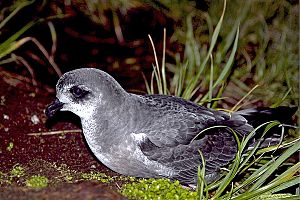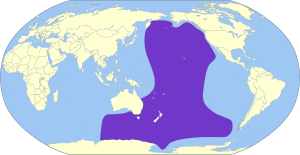Mottled petrel facts for kids
Quick facts for kids Mottled petrel |
|
|---|---|
 |
|
| Conservation status | |
| Scientific classification | |
| Genus: |
Pterodroma
|
| Species: |
inexpectata
|
 |
|
The mottled petrel (Pterodroma inexpectata), also known as the kōrure, is a type of seabird. It belongs to a group of birds called gadfly petrels. This bird is usually about 33 to 35 centimeters (13 to 14 inches) long. Its wings can spread out to about 74 to 82 centimeters (29 to 32 inches) wide.
Life at Sea
Mottled petrels spend most of their lives far out in the ocean. They are known as pelagic birds, which means they live in the open sea and rarely come close to land. The only time they visit land is to build their nests and raise their young chicks.
These birds are skilled hunters in the ocean. They mainly eat fish and squid. Sometimes, they also catch small crustaceans, which are like tiny sea creatures with hard shells.
Amazing Journeys
The mottled petrel is a transequatorial migrant. This means it travels huge distances across the equator every year! They breed and lay their eggs on islands in New Zealand. After their chicks are grown, they fly all the way to the Bering Sea in the northern Pacific Ocean. They often gather in large numbers in places like the Gulf of Alaska and the Aleutian Islands during this migration.
Nesting and Challenges
When it's time to nest, mottled petrels look for safe spots on land. They often use burrows (tunnels dug in the ground) or hide their nests in rock crevices.
Sadly, there are fewer mottled petrels today than there used to be. Their numbers have gone down because of animals that were brought to their nesting islands by people. These introduced animals, like rats or stoats, hunt the petrel chicks and eggs.
To help these birds, young mottled petrel chicks have been moved to new, safer areas. For example, some chicks were reintroduced to the Maungaharuru hills in Hawke's Bay, New Zealand, which are about 24 kilometers (15 miles) from the sea. This helps protect them from predators and gives them a better chance to survive.
Images for kids
-
Pterodroma inexpectata, from the Auckland Museum collection
See also
 In Spanish: Petrel moteado para niños
In Spanish: Petrel moteado para niños



